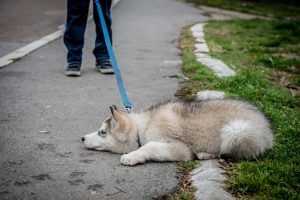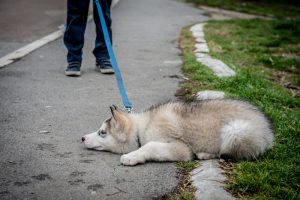
If you want to talk about high stakes situations, how about the negotiation process when your dog refuses to return home at the end of a walk or trip to the dog park? The more you tug on the leash, the more your pup digs their claws into the ground, and the more you can feel everyone staring. If you’ve been in this situation, every outing with your dog can bring on a sense of dread at getting them back in the car or house. You might also worry that your dog will give their friendly Dog Walker a hard time or that at a certain point, your pup will simply turn tail and run away from you. But, luckily, there are some simple tricks that you can use to end the behaviour for good.

First, let’s figure out why your dog refuses to return home
When your dog runs laps around the dog park, cleverly avoiding where you’re standing with leash in hand, it can feel like your dog is being downright vindictive.
But, of course, that’s not the case at all. While our dogs want approval and praise, they also want to have fun. And, they might have learned that the moment you bring out that leash, fun time is over.
What’s more, if you’ve shown (understandably) frustration about this game of cat and mouse in the past, your pupper has even more reason to hold onto those last wonderful moments of freedom. They might think that the end of their time outside doesn’t only mean an end to the fun but also an unpleasant welcome home.
While the desire to keep playing is the most common reason dogs refuse to return home, there could be other factors at play here. Your dog may be dealing with car sickness or remembering that last week, you took them to the groomers right after their outing. If they refuse to round the last corner to your house, it could be that the neighbour’s big scary dog likes to bark at them as they pass.
The more you take note of your dog’s behaviours and environment, you’ll be able to pick out patterns that reveal why they’re pretending to ignore you when you call.
From there, you can put together a plan to fix the problem.
Emergency situations: what to do when your dog refuses to return home and runs loose
Before we get into some longer term training methods that will end the avoidance behaviour completely, it’s helpful to have a plan for emergency situations. After all, if your dog is off leash in an open area where they could easily get lost or injured, you want to get them back ASAP. Here are a few things that you can try in the moment:
- If your dog won’t come, give them another command. If we’re not careful, the word “come” or “here” can become associated with an end to playtime for our pups. That can make it a hit-or-miss command in emergency situations. If your dog isn’t responding to the recall command, try a different one like “sit” or “lay down.” It might give you just enough time to approach your pup and leash them up.
- Try getting their attention with a surprise. Even when our dogs appear to be ignoring us, they’ve usually got an ear trained in our direction. So, to get them to come to you quickly, try making a strange, unexpected noise and run away from your dog. Yes, you will make a scene! But in most cases, your dog will run over out of curiosity and you can safely secure them.
- Ask a bystander for help. People-oriented dogs may respond more quickly to the attention of a stranger than your calls. So, if your pup is running down the street, don’t be afraid to flag down a bystander up ahead with, “My dog’s name is Fido. Please call him!” With even a momentary distraction from a stranger, your pup may pause long enough for you to win back their focus.
As you’ve probably guessed, these are not long term solutions to your dog’s avoidance behaviour. It’s a good idea to have these last resort options in your back pocket for emergency situations, but training for better recall is the main priority.
What to do when your dog refuses to return home from a walk
Here are a few ways to ensure that your dog won’t see the end of their walk as the end of the world:
- Switch up the route. Dogs are creatures of habit, and if you take them on the same route every day, they’ll start to anticipate when the walk is coming to an end. You can disrupt this habit by taking your pup on new walking routes and coming home from different directions. You might even trick them by walking to your front door as if to end the walk, and then turning around and continuing on your way. These switch-ups will make it harder for your dog to predict when the walk will end, and provide an added bonus of extra mental stimulation!
- Give your pup something to look forward to. As much as your dog loves their daily walk, try to arrange for something even more exciting to take place when they get home. This might include some one-on-one time with you, such as a fun training session or playtime. Or, you might walk them directly before feeding them their mouth-watering bowl of fresh raw dog food. The tastier the meal, the more excited they’ll be to get back to the house after their walk.
- Schedule frequent walks during the day. We can’t blame our doggos for wanting to be outside. And if they only get one long walk per day, it’s understandable that they would refuse to go back inside. You might be able to ease their resistance by giving them more opportunities to exercise outside, such as a visit from their favourite Dog Walker.
- Entice them with treats. It may take a while for your dog to stop seeing the end of their walk with dread. In the meantime, treats can be a big help. Instead of playing tug-of-war with your dog’s leash, offer them a reward for walking alongside you as you approach the house. If they’re still hesitant, try swapping out their regular treats for something even tastier.
How to entice your pup to get in the car after an adventure
It’s one thing to struggle with your pupper at the driveway as you’re coming back from your walk. It’s quite another to be out in public when your dog refuses to come back to the car. In some ways, this is a more high-stake situation, so you want to focus on quick and enthusiastic recall.
One way to do this is with high reward treats. If your dog goes wild for boiled chicken or bits of deli meat, this will be one of the few times that you use it to get them excited about coming back to the car.
And, you’ll want to start the training when your car is still at home. Throughout the day, bring your dog out to the car and have them hop in for a tasty treat. You can also introduce a command, such as “hop in” or “time to go” to signal that you want them to get in the car. Give them plenty of praise every time they get in the car.
You can also make a game out of getting into the car. For this, you’ll want to bring their favorite toy and simply toss it into the backseat for them to get it.
The idea, here, is to reestablish your dog’s relationship with the car. With daily short training sessions, your pup will start to see the car as something rewarding. And once they’ve become comfortable at home, you can take it to the next step by driving to a new location, preferably one less exciting than the dog park but still safe enough to test out your dog’s recall skills.
Final steps towards ending the show-down for good
Teaching your dog to come home after an outing is a matter of safety. But it will also make your life much easier! With regular practice, the help of a Dog Walker, and some tasty treats, your pupper will be excited to come back home after their adventures.
Have any tricks of your own for when your dog refuses to return home?